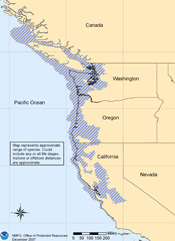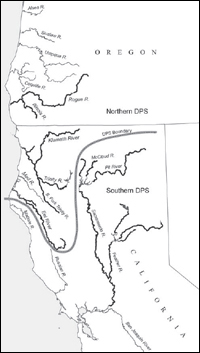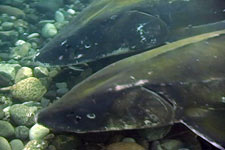Green Sturgeon (Acipenser medirostris)
Status | Taxonomy | Species Description | Habitat | Distribution |
Population Trends | Threats | Conservation Efforts | Regulatory Overview |
Key Documents | More Info
Status
ESA Threatened - Southern DPS
ESA Species of Concern - Pacific-northern DPS (including coastal spawning populations from the Eel River north, to the Klamath and Rogue rivers)
Taxonomy
Kingdom: Animalia
Phylum: Chordata
Class: Osteichthyes
Order: Acipenseriformes
Family: Acipenseridae
Genus: Acipenser
Species: medirostris
Species Description
Green sturgeon are long-lived, slow-growing fish and the most marine-oriented of the sturgeon species. Mature males range from 4.5-6.5 feet (1.4-2 m) in "fork length" and do not mature until they are at least 15 years old (VanEenennaam, 2002), while mature females range from 5-7 feet (1.6-2.2 m) fork length and do not mature until they are at least 17 years old. Maximum ages of adult green sturgeon are likely to range from 60-70 years (Moyle, 2002). This species is found along the west coast of Mexico, the United States, and Canada.
Although they are members of the class of bony fishes, the skeleton of sturgeons is composed mostly of cartilage. Sturgeon lack scales; however, they have five rows of characteristic bony plates on their body called "scutes". The backbone of the sturgeon curves upward into the caudal fin, forming their shark-like tail. On the ventral, or underside, of their flattened snouts are sensory barbels and a siphon-shaped, protrusible, toothless mouth. Recent genetic information suggests that green sturgeon in North America are taxonomically distinct from morphologically similar forms in Asia.
Green sturgeon are believed to spend the majority of their lives in nearshore oceanic waters, bays, and estuaries. Early life-history stages reside in fresh water, with adults returning to freshwater to spawn when they are more than 15 years of age and more than 4 feet (1.3 m) in size. Spawning is believed to occur every 2-5 years (Moyle, 2002). Adults typically migrate into fresh water beginning in late February; spawning occurs from March-July, with peak activity from April-June (Moyle et al., 1995). Females produce 60,000-140,000 eggs (Moyle et al., 1992). Juvenile green sturgeon spend 1-4 years in fresh and estuarine waters before dispersal to saltwater (Beamsesderfer and Webb, 2002). They disperse widely in the ocean after their out-migration from freshwater (Moyle et al., 1992).
The only feeding data we have on adult green sturgeon shows that they are eating "benthic" invertebrates including shrimp, mollusks, amphipods, and even small fish (Moyle et al., 1992).
 Green Sturgeon Range Map (click for larger view PDF) |
|
 Green Sturgeon DPS Map Image: NOAA (click for larger image) |
Habitat
Green sturgeon utilize both freshwater and saltwater habitat. Green sturgeon spawn in deep pools or "holes" in large, turbulent, freshwater river mainstems (Moyle et al., 1992). Specific spawning habitat preferences are unclear, but eggs likely are broadcast over large cobble substrates, but range from clean sand to bedrock substrates as well (Moyle et al., 1995). It is likely that cold, clean water is important for proper embryonic development.
Adults live in oceanic waters, bays, and estuaries when not spawning. Green sturgeon are known to forage in estuaries and bays ranging from San Francisco Bay to British Columbia.
In September 2008, NMFS proposed critical habitat for the Southern DPS [pdf].
Distribution
Sturgeon are found in North America and Eurasia. Green sturgeon are the most broadly distributed, wide-ranging, and most marine-oriented species of the sturgeon family. The green sturgeon ranges from Mexico to at least Alaska in marine waters, and is observed in bays and estuaries up and down the west coast of North America (Moyle et al., 1995).
Population Trends
No good data on current population sizes exists and data on population trends is lacking.
Threats
A principal factor in the decline of the Southern DPS is the reduction of the spawning area to a limited section of the Sacramento River. This remains a threat due to increased risk of extirpation due to catastrophic events. Insufficient freshwater flow rates in spawning areas, contaminants (e.g., pesticides), bycatch of green sturgeon in fisheries, potential poaching (e.g., for caviar), entrainment by water projects, influence of exotic species, small population size, impassable barriers, and elevated water temperatures likely pose a threat to this species.
Conservation Efforts
Fishing regulations and conservation measures represent a reduction in risk to green sturgeon. California, Oregon, Washington (United States) and British Columbia (Canada) have restricted commercial and sport fisheries where green sturgeon occur (IUCN Red List of Threatened Species ![]() ). Recent implementation of sturgeon fishing restrictions in Oregon and Washington and protective efforts put in place on the Klamath, Trinity, and Eel Rivers in the 1970s, 1980s, and 1990s may offer protection to the Southern DPS. The recent closure of the California recreational fishery may also provide beneficial to this species. The most important conservation currently occurring is the change in operations of Red Bluff Diversion dam (open from mid September to mid May) allowing access to spawning areas above the dam. Originally, the dam was closed year around.
). Recent implementation of sturgeon fishing restrictions in Oregon and Washington and protective efforts put in place on the Klamath, Trinity, and Eel Rivers in the 1970s, 1980s, and 1990s may offer protection to the Southern DPS. The recent closure of the California recreational fishery may also provide beneficial to this species. The most important conservation currently occurring is the change in operations of Red Bluff Diversion dam (open from mid September to mid May) allowing access to spawning areas above the dam. Originally, the dam was closed year around.
Regulatory Overview
After completion of a study of its status (Adams et al., 2002) in 2002, NMFS determined that the green sturgeon is comprised of two DPSs that qualify as species under the ESA, but that neither warranted listing as threatened or endangered [pdf] (68 FR 4433). Uncertainties in the structure and status of both DPSs led NMFS to add them to the Species of Concern List [pdf] (69 FR 19975).
The "not warranted" determination was challenged on April 7, 2003. NMFS produced an updated status review on February 22, 2005 and reaffirmed that the northern green sturgeon DPS only warranted listing on the Species of Concern List, however proposed that the Southern DPS should be listed as threatened under the ESA. NMFS published a final rule on April 7, 2006 listing the Southern DPS as threatened [pdf] (71 FR 17757), which took effect June 6, 2006.
In September 2008, NMFS proposed critical habitat for the Southern DPS [pdf]. The public comment period was extended to December 22 for the proposed critical habitat.
On May 21, 2009, NMFS proposed a 4(d) rule [pdf] to apply ESA take prohibitions to the Southern DPS.
Key Documents
(All documents are in PDF format.)
| Title | Federal Register | Date |
|---|---|---|
| Proposed 4(d) Rule | 74 FR 23822 | 05/21/2009 |
| Proposed Critical Habitat for the Southern DPS | 73 FR 52084 | 09/08/2008 |
| Species of Concern Fact Sheet: Pacific-northern DPS |
n/a | 03/27/2007 |
| ESA Listing Rule for Southern DPS | 71 FR 17757 | 04/07/2006 |
| Status Review Update (2005) | n/a | 02/2005 |
| n/a | 06/2002 |
- NMFS Northwest Regional Office Green Sturgeon Information
- Center for Biological Diversity Petition to List Green Sturgeon
 [pdf]
[pdf] - IUCN Species Information

Literature Cited
Adams, P.B., C.B. Grimes, J.E. Hightower, S.T. Lindley, and M.L. Moser. 2002. Status Review for the North American green sturgeon. NOAA, National Marine Fisheries Service, Southwest Fisheries Science Center, Santa Cruz, CA. 49 p.
Adams, P.B., C.l. Grimes, J.E. Hightower, S.T. Lindley, M.L. Moser, and M.J. Parsley. In Press. "Population Status of North American Green Sturgeon, Acipenser medirostris" ![]() Environmental Biology of Fishes.
Environmental Biology of Fishes.
Beamesderfer, R.C.P. and M.A.H. Webb. 2002 Green sturgeon status review information. S.P. Cramer and Associates, Gresham, Oregon, U.S.
Moyle, P.B., P.J. Foley, and R.M. Yoshiyama. 1992. Status of green sturgeon, Acipensermedirostris, in California. Final Report submitted to National Marine Fisheries Service. 11 p. University of California, Davis, CA 95616.
Moyle, P.B., R.M. Yoshiyama, J.E. Williams, and E.D. Wikramanayake. 1995. Fish Species of Special Concern in California. Second edition. Final report to CA Department of Fish and Game, contract 2128IF.
Moyle, P.B. 2002. Inland fishes of California. University of California Press, Berkeley, CA. 502 pp.
Scheiff, A.J., J.S. Lang, W.D. Pinnix. 2001. Juvenile salmonid monitoring on the mainstem Klamath River at Big Bar and mainstem Trinity River at Willow Creek 1997-2000. USFWS, AFWO, Arcata, CA 95521, 114 pp.
Van Eenennaam, J. P. 2002. Personnel Communication. In Adams, P.B., C.B. Grimes, J.E. Hightower, S.T. Lindley, and M.L. Moser. 2002. Status Review for the North American green sturgeon. NOAA, National Marine Fisheries Service, Southwest Fisheries Science Center, Santa Cruz, CA. 49 p.
